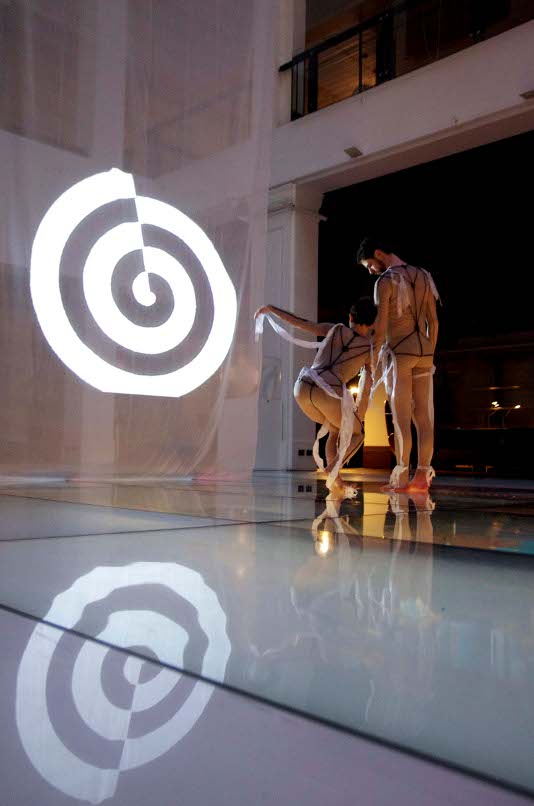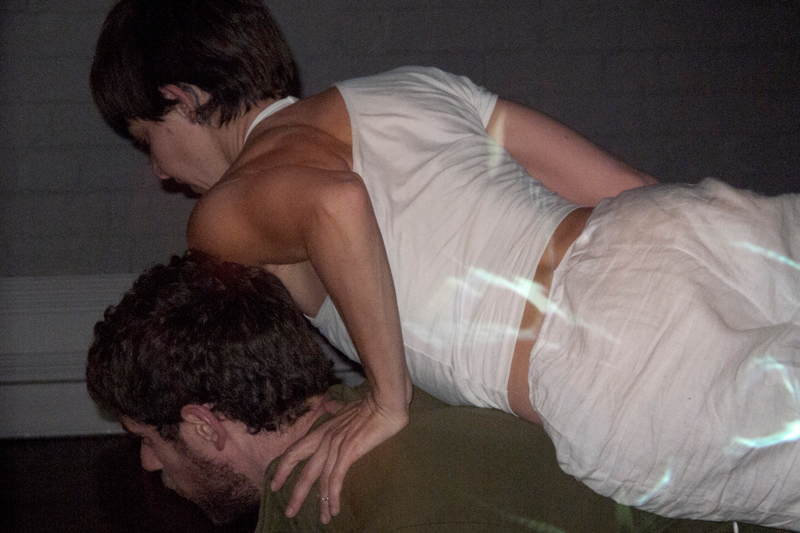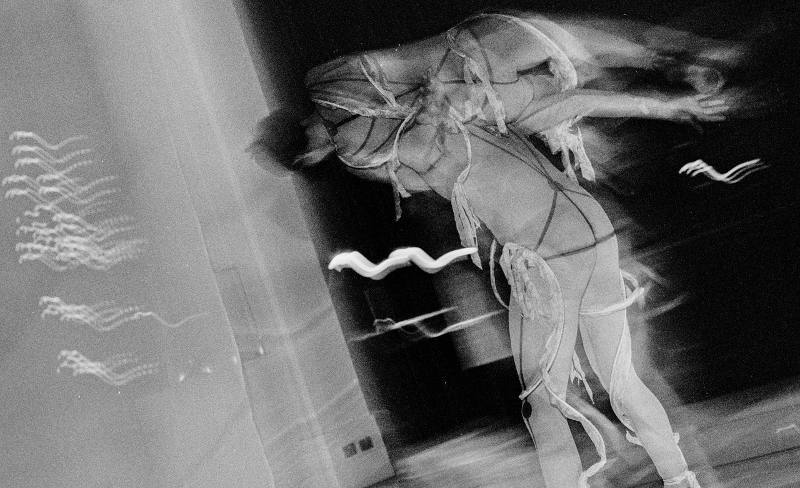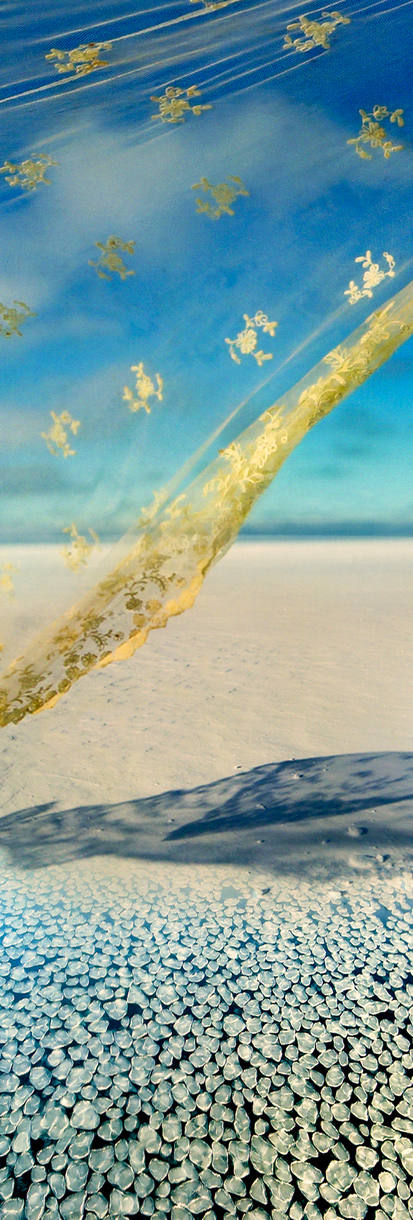Living Data
Animating Change: Impacts
| Exhibition |
Forum |
Dance |
Interviews |
Impacts |
Do Living Data presentations visualise changing relationships between living things? Emailyour response.
See PHOTOS VIDEOSand EMAILSthat reflect impacts of the 2012 Living Data exhibition program.
What can photos tell us?

Dancers: Ashley Macqueen,
Caterina Mocciola.
Photo: Stephen Pierce
The Living Data performances at The Muse and Customs House changed the usual ways the public interact with these spaces. The Muse, normally a presentation space for Sydney Institute, and Customs House, now a Library, were transformed into Living theatre in the round. Customs House especially, with its massive central void, enabled the performance to go beyond presenting animation, set, music and dance upon a stage. Relationships between observers and performers opened up. The ability to see around, through and down to the performance space changed the relationship between observers and performers, enabling points of view and perspectives not visible in the traditional sitting in rows staring at a stage arrangement. The traditional stage is placed in front of you as compared to the infinite angles provided at Customs House. Architecture enveloped the multi-media performance to form a single "total work" where the sum of the elements gave everyone involved a sense of being part of a whole experience.
The all-enveloping nature of the Customs House performance took my role as photographer away from the traditional responsibility of documenting an event or moment. I became an unknowing participant; photographers at work became part of the dance. Lying with camera in hand on the glass floor of Customs House, I was surrounded by dancers, musicians, animations, costumes and sets. The all embracing nature of the performance shifted me and the audience from being witnesses to elements within the total work and its message.

Dancers: Ashley Macqueen,
Caterina Mocciola.
Photo: Paul Sutton
University of Technology, Sydney (UTS)
What can photographs tell us?
The photograph you have chosen, along with all the photographs I made of Caterina and Ashley dancing, is merely an interpretation of one moment of one performance. As a document of this performance's impact on me, or as a vehicle for conveying what I felt while witnessing this performance, it, and all of the others, is an ineffective image. This is not to say that this photograph is without merit. I am simply saying that my experience of this image is completely different to my experience of the performance. If for others this photograph has one tenth of the affective power that I felt during Cat and Ash's dance then my work has been worthwhile.
I am looking at your photos from the Muse and Customs House and seeing how you make visible the tenderness I felt, between the people and those very different places.
I am interested in what you say about tenderness between people and how this is conveyed via photographs. While I have given a lot of thought to rapport between the photographer and the portrait subject I have not really considered connections between people on the other side of the camera. I am pleased to know that you feel these connections in my photographs from both The Muse and Customs House, particularly because I do not see myself as a portrait photographer.
On reflection, I definitely felt a connection between the dancers, Ashley and Caterina, and this connection was beautifully expressed via their movements. As a third person, I felt honoured and privileged to be able to photograph their performances. Ashley and Caterina's performances definitely had an affective impact on me, particularly their dance at The Muse.
Where and how we point a camera reveals our field of view. Our frame reflects the limits of our knowledge and experience. Seeing through someone's frame may expand our understanding.
What happens when the camera or the image frame is not looked at when the photograph is made? Some photographers, myself included, occasionally photograph this way. (This image of Cat and Ash is not a good example of this, but there were nonetheless many indeterminate elements involved when this photograph was made) While I have not given a lot of thought to the meaning of this method in my own practice, not until now at least, I believe it is a good way of removing the ego from the act of making photographs. It introduces me to ways of seeing that I could never think of. It makes me humble and helps me realise that at the exposure stage the camera does a lot of the work. What the camera sees when I am looking elsewhere often expands my understanding and my awareness.

Photo: Jennifer Chua
University of Technology, Sydney (UTS)

Photo: Susan Barnett
Here's an image of the banner I travelled with overseas. The wedding veil is about 200 years old, an heirloom of Brussels lace made by Nuns in France. That's the story Mum told me.
I photographed the veil as it moved to the rhythm of the Antarctic breeze, casting a poignant shadow on the ice as air lifted it. The veil danced approvingly of its journey through unique landscapes, cultures and across diverse continents...
My Mother Shirley never had the opportunity to venture beyond the shores of New Zealand but aspired to travel. Shirley's journey has now begun.
Susan Barnett. Mt Kembla, NSW. 12 Nov 2012
Video recordings of the same event relect different viewpoints.
Cinematography: Leva Pertle. Video editing: Lisa Roberts
Music: From Caravans 1997 Derek Davies
Cinematography: Leva Pertle. Video editing: Lisa Roberts
Music: From Caravans 1997 Derek Davies
Cinematography/editing: Lisa Roberts
Music: ambient sounds
I walk you though an exhibition, leading you in a (more or less) clockwise direction. I try to give you my sense of being there, lingering in shadows and reflections, as if you're in my shoes. I show you lines that catch my eye, that dance in patterns through the art and architecture: a choreography of circling, spiralling and crossing algae, krill, sea butterflies, seals, humans and common grass seeds.
From: Robert Hunter Stephenson,animator/teacher
To: Lisa Roberts
Subject: Re: Impacts of our work
Date: Wed, 30 Jan 2013 22:22:18 +0000
Your work has straddled, or really knitted together the world of science and art in a beautiful, thoughtful and poetic way. It is most certainly inspiring and has been helpful already discussing with our students areas other than the obvious where animation can be applied.
From: Virginia King,sculptor
To: Lisa Roberts
Subject: Re: Impacts of our work
Date: Tue, 13 Nov 2012 11:51:43 +1300
A couple of decades ago I made the decision to concentrate my artwork on the marine environment. Initially, I found it difficult to access scientific imagery of microbial life forms. However in 1999 I had the opportunity to meet marine micro biologists in Antarctica, through the NZ Artists to Antarctica program. The scientists made available electron microscope images of diatoms, selected from resource material, processed from an ice core. This fundarmental information has allowed my work to evolve using current scientific research. The resulting body of work focussed attention on life forms at the beginning of the food chain.
I'm excited to see Living Data, an exhibition that combines science and art; artwork informed by the intense beauty of the microsphere. There is powerful inspiration in 'less than visible' forms fo life, that are brought to our attention using images scientifically generated and translated into artworks. It has seemed curious to me there had been so little collaboration, exploration and investigation by artists into this seemingly magical microbial world, made visible through the world of science.
Recently I created for public exhibition, a two metre diametre sculpture in stainless steel, a marine micro organism, Radiolaria. We are frighteningly close to extinction. I am attempting to raise awareness of the acidification of global oceans. Radiolaria and other microbial life absorbs and converts carbon in our currently endangered oceans. By making my artwork tactile and sensual in the hope that people will be drawn to it - and hopefully take another step towards saving the source.
From: Susan P Barnett
To: Lisa Roberts
Subject: RE: Impacts of our work
Date: Mon, 12 Nov 2012 10:45:04 +1100
I am very happy to support the ethos of the Livingdata Project. This is one of the most stunning projects I've seen in a long time. Totally inspiring, unique, profoundly beautiful. The issues concern us all. It's a skill to convey critical (and at times political) information via a creative medium.
It would be great if Living Data could be discussed with primary and high school students. After all it's their responsibility in the future to be a voice for the voiceless.
In 2003 I visited a penguin rookery near Davis Station and photographed a dead penguin's foot, which had the remnants of a fishing net wrapped around it's leg and on Macquarie Island I photographed a dead Sea Lion , who had been impaled by a piece of steel attached to a rope, wrapped around its neck! This was such a visual extreme and cruel contrast to how Antarctica is portrayed and viewed.
You cannot acknowledge only the beauty of Antarctica, the state of its oceans is a concern for everyone, where tons of plastic from around the world find its way into one of the most precious sanctuaries on this planet, whales rely on Antarctic waters to feed on Antarctic krill , small fish and Plankton but are viciously hunted down in Antarctica, Patagonian Tooth Fish were fished to near extinction, female Wandering Albatross drown when they swallow the frozen bait, which sits on the ocean's surface from long-line fishing trawlers, and are violently dragged into the depths of the ocean. Another cruel and profoundly unnecessary death of wildlife.











